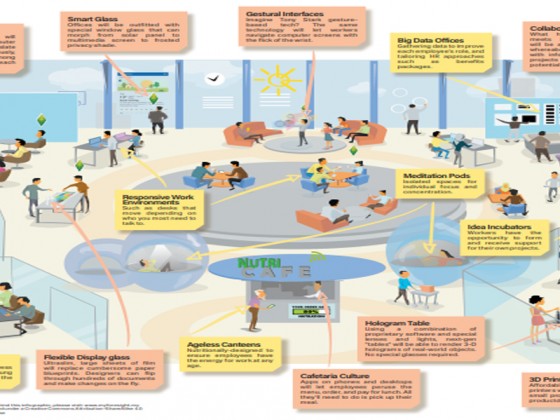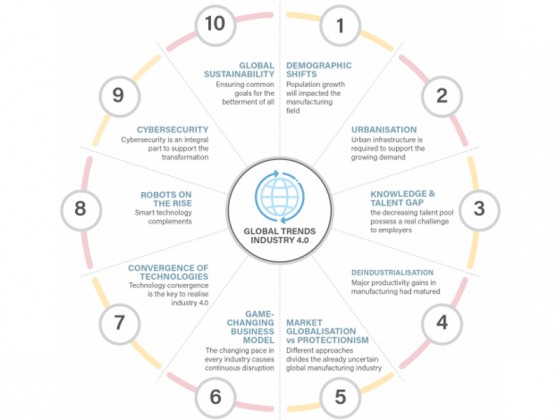According to the Global Manufacturing Competitiveness Index, Malaysia is ranked 17th and is projected to climb four places to 13th by the year 2020.
by | Rushdi Abdul Rahim | rushdi@might.org.my
The last 3 months have been an enriching experience for us at MIGHT. In collaboration with the Ministry of International Trade & Industry (MITI), we have been working on the framework for Industry 4.0 technology and processes adoption in Malaysia. Essentially, this framework will outline generic strategies for Malaysia to pursue, and ensuring that the country will remain competitive in the future.
Focusing on the manufacturing sector, the goal for the future the industry is not only to make better things, creating better and innovative products as well as services, but to also to make things better, improving the design, engineering, management and production processes.
Although for the past few years there have been steady improvements in the manufacturing output and employment in the sector, renewed investments are vital to build the necessary infrastructure and increase resources to support the continuous growth.
To that extent, the transformation of Malaysia’s manufacturing industry is required due to the following factors:
Continuous Gross Domestic Product (GDP) growth
♦♦ At present Malaysia GDP growth remains resilient, on-track with its targeted annual GDP growth of 5.1 percent under the 11th Malaysia Plan (11-MP);
♦♦ The manufacturing sector is still a major contributor to the national GDP. In 2016, it contributed approximately 23 percent to the national GDP; and
♦♦ It is acknowledged that Malaysia needs to move from input-driven growth which is more capital intensive to an innovation led productivity-driven growth.
Increasing National Productivity
♦♦ Malaysian productivity remains ranked 44th position in 2016 for Labour productivity per hour worked. This has remain almost unchanged since 2009 where we were also ranked 44th;
♦♦ The labour productivity growth from 2011 to 2015 was at 3.2 percent, whereas in 2016 it has risen slightly to 3.6 percent. However this still falls short of our neighbouring countries like Singapore and Thailand; and
♦♦ Presently under the 11-MP, the manufacturing industry productivity is targeted to grow approximately 2.6 percent year-on-year. There is a need to boost this growth through automation, digitalisation and smart technology and processes adoption.
Creating Higher Skill Employment Opportunities
♦♦ Malaysia is no longer able to rely on cheap labour as a competitive factor hence the focus on the creation of high-skilled jobs;
♦♦ There is an urgent need for us to move away from low-skilled/foreign workers dependency particularly for the manufacturing industry;
♦♦ The proportion of skilled labour in Malaysia has declined from 27.6 percent of total employment in 2010, to 25.5 percent of total employment in 2015; and
♦♦ Since there is a focus on high technology and value added manufacturing activities, Malaysia needs to grow the number and diversity of its STEM-educated or TVET-educated workforce, establish greater opportunities for high skill employment.
Remaining Competitive
♦♦ To remain competitive and relevant, the manufacturing firms must innovate—investing and adopting new technologies that will enabled more efficiency and increase quality; and
♦♦ Anticipate, looking for new business and collaborative model – work hand-in-hand with partners in the ecosystem to generate better products and services.
These factors also identified some gaps in the manufacturing industry that hindered development progress such as—labour intensive with relatively higher labour costs compared to our neighbours, lack of technology adoption and a small domestic market. The move to smart manufacturing processes and systems are seen as steps to stay abreast with the rest of the world and opening up markets where the nation has comparative cost advantages.
According to the Global Manufacturing Competitiveness Index, published in 2016 by the Deloitte Touche Tohmatsu Limited (DTTL) Global Consumer & Industrial Products Industry Group and the Council on Competitiveness, USA, Malaysia is ranked 17th and is projected to climb four places to 13th by the year 2020.
However, this rise is not given, as the report outlined, that in order to succeed in the rapidly evolving global manufacturing landscape industries will need to embrace a targeted approach to some of the key elements of manufacturing competitiveness.
Therefore, it is apt that the overarching strategy for this framework is to ACT—attract, create and transform.
♦♦ Attract stakeholders to Industry 4.0 technologies & processes;
♦♦ Create the right ecosystem for Industry 4.0 to be adopted; and
♦♦ Transform the industry to smart manufacturing, be Industry 4.0 ready and adopt its’ technology and business practices.
At present MITI has already put the draft of the framework in public domain to solicit further inputs from the stakeholders.
In this publication, highlight some of the main drivers and trends of Industry 4.0 as well as the technology that has and will enable the manufacturing sector transformation.
I hope upon reading the articles in this publication, you will acquire thoughts and ideas to provide feedback to the Ministry.
As usual we welcome any comments, suggestion and contributions of ideas.









